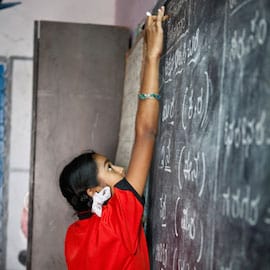Welfare Schemes Don’t Work if Nobody Knows About Them: Fixing India’s Information Deficit
According to the World Bank, some 270 million people in India live below the poverty line. The reality is grim. Children have no access to proper education, families live without basic health care, the elderly struggle without pensions and the unemployed face an uncertain future. Although there are a number of government welfare schemes that address these issues, they are often beyond the reach of those who need them the most – the illiterate Indian citizen, living in rural locations, with limited means.
To blame the government alone is unfair. An information drought occurs despite the government’s best efforts in creating awareness through radio, TV, print or online media. Unfortunately, these communication efforts often do not reach rural areas. For example, in Uttar Pradesh, one of India’s poorest states, between 2013 and 2017, there was more than US $1.3 billion in unspent funds for minority welfare schemes. In Karnataka, although US $735 million was collected to be used as welfare schemes for workers, only 2.44 percent was used due to lack of awareness of such programs.
The story is the same across other Indian states. Although there are welfare schemes available, the information deficit is just too great. More worryingly, basic supply-demand metrics can come into play. If there is no demand for a set of welfare schemes, the government will not be incentivized to focus on their implementation or to increase available funds in the future.
Information as a fundamental right
We believe information is a fundamental right. Every citizen must know his/her entitlements. This lack of awareness of welfare schemes can be solved through an efficient collaboration between the government and private enterprise. At the state and national level, there needs to be a simple platform that provides easy, accurate and reliable information about the welfare schemes, the eligibility criteria and the application process.
In India, there are Common Service Centres, which provide information about central and state government schemes and services. Unfortunately, this information is often fragmented, as it is limited to a small number of schemes and does not cover all schemes available. When the information is available on the internet, it may be hard for poor rural citizens to access it. Adding to this information deficit is a lack of clarity when it comes to which individuals are eligible for which schemes.
The Haqdarshak model
We set up Haqdarshak as a technology platform to address this problem, using a combination of technology and a network of people, to transform the way people find out about, apply for and benefit from various welfare schemes. First, we gathered information on government welfare schemes, their eligibility criteria and the application process. This involved visiting numerous government departments and conducting extensive research. This information was incorporated into our Haqdarshak mobile app and web platform (which also cover private schemes, though these don’t suffer from the same issues that plague their government counterparts). We trained rural women villagers how to use our mobile app and these became our Haqdarshak entrepreneurs. These women go door-to-door, collecting information from their neighbors and informing them which schemes they are eligible for. They charge a fee, resulting in employment and greater financial independence. This fee is paid directly by citizens to the Haqdarshak entrepreneurs for their screening and application services. These entrepreneurs in turn pay a fixed monthly service fee to Haqdarshak.
We quickly realised that active participation from the community is one of the strongest tools for creating awareness. This is particularly so in the Indian hinterlands, where people still trust information passed by word-of-mouth more than what they read on a tech gadget. Success stories are shared widely in villages and people often need this assurance when it comes to welfare schemes.
The Haqdarshak model promotes women’s empowerment, which is critical in India, especially in rural areas where employment opportunities are rare. Our Haqdarshak entrepreneurs can work in their spare time, while earning significant revenue – on average between Rs 3,000 to 5,000 a month. This often is put toward their children’s education. We have heard critics complain that the rural pool of unemployed individuals are often unskilled and uneducated, and therefore underperform when given jobs. We have not found this to be so. When trained well, our Haqdarshak entrepreneurs perform just as well as urban dwellers.
Building a sustainable enterprise
While every social enterprise in India looks at making a change, how the change is created is equally important. Our model is currently operational in eight Indian states, and we are trying to build a sustainable social enterprise with a two-pronged approach — empowering field workers with a stable source of income and giving citizens what they are entitled to. Currently, approximately 75 percent of our revenue comes from service contracts, which are mainly partnerships with corporates and organisations, 15 percent comes from our operational revenue (fees paid by Haqdarshak entrepreneurs) and the remaining 10 percent from grants. Moving forward, we aim to increase our share of operational revenue to 40 percent and drop the share from service contracts to 50 percent.
Our solution will solve multiple problems, but for India to be a truly major economic power, the overlap between government and private resources is key. Creating livelihoods, empowering citizens and establishing a fair and transparent social and economic system should be our ultimate goal.
Aniket Doegar is the CEO and co-founder at Haqdarshak.
Madhura Karnik is a senior associate at Haqdarshak.
- Categories
- Education, Social Enterprise, Technology



